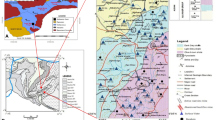Abstract
Fluoride is a common constituent in most of the rocks and the release of fluoride into groundwater is the major problem in several parts of the world. The present study was carried out with the objective of identifying sources and mechanism of release of fluoride from the rocks and its impact on human health in Vaniyar river basin, Dharmapuri district, Tamil Nadu. Groundwater samples were collected from 44 wells once in 2 months from June 2011 to August 2014 and analyzed for major cations and anions using an ion chromatograph. The possible reasons for the increased concentration of fluoride in groundwater of the area were investigated by taking into account of the agricultural practises and the major rock types in the area. The observed order of the dominance of cations in groundwater in the study area is Na+ > Ca2+ > Mg2+ > K+ and that of anions is Cl− > HCO3 − > SO4 2− > CO3 − > F−. The fluoride concentration in groundwater of this region ranges from 0.15 to 6.14 mg/l. Out of 569 samples analysed, fluoride concentration exceeded the maximum permissible limit of the drinking water standards of BIS 1.5 mg/l in 396 samples. Many people living in this area are suffering from dental and skeletal fluorosis due to prolonged use of fluoride-rich groundwater for drinking. Concentration of fluoride in groundwater is relatively low in wells located in charnockite region, whereas the concentration of fluoride in groundwater is high in the deep wells in regions comprising of epidote hornblende biotite gneiss. The major source of fluoride in groundwater in the area is due to leaching of fluoride-bearing minerals. Fluoride ions from biotite and hornblende minerals leach into the groundwater and contribute high fluoride concentration in this region. The concentration of fluoride in groundwater increases when the water level is deep indicating higher release of fluoride from greater depth. The geochemical reactions that control the release of fluoride from fluoride-bearing minerals such as biotite and hornblende into groundwater were identified. Removal of high concentration of fluoride from drinking water is necessary in this region and measures should be taken to supply water after removal of fluoride for the betterment of the livelihood in the area.














Similar content being viewed by others
References
Arlappa N, Aatif QI, Srinivas R (2013) Fluorosis in India: an overview. Int J Res Dev Health 1:97–102
BIS (2012) Bureau of Indian Standards Drinking water-specification. IS: 10500, New Delhi
Brindha K, Elango L (2011) Fluoride in groundwater: causes, implications and mitigation measures. In: Monroy SD (ed) Fluoride Properties, Applications and Environmental Management, pp 111–136
Brindha K, Elango L (2013) Geochemistry of fluoride rich groundwater in weathered Granitic Rock Region, Southern India. Water Qual Expo Health 5(3):477–478
Brindha K, Rajesh R, Murugan R, Elango L (2011) Fluoride contamination in groundwater in parts of Nalgonda District, Andhra Pradesh, India. Environ Monit Assess 172:481–492
Carroll D (1962) Rainwater as a chemical agent of geological processes-A review. U.S. Geological Survey Water-Supply Paper 1535-G, p 18
Central Ground Water Board (2009) South Eastern Coastal Region Chennai. District groundwater brochure Dharmapuri district, Tamil Nadu, India
Chidambaram S, Bala KM, Karmegam U, Singaraja C, Anandhan P, Prasanna MV, Manikandan S (2013) Environmental hydrogeochemistry and genesis of fluoride in groundwaters of Dindigul district, Tamilnadu (India). Environ Earth Sci 68:333–342
Chouhan S, Flora SJS (2010) Arsenic and fluoride: two major groundwater pollutants. Indian J Exp Biol 48:666–678
Farooq SH, Chandrasekharam D, Norra S, Berner Z, Eiche E, Thambidurai P, Stüben D (2011) Temporal variations in arsenic concentration in the groundwater of Murshidabad District, West Bengal, India. Water Res 44:5575–5578
Freeze RA, Cherry JA (1979) Groundwater. Prentice Hall, Englewood Cliffs
Gago C, Romar A, Fernández MML, Álvarez E (2014) Fluoride sorption and desorption on soils located in the surroundings of an aluminium smelter in Galicia (NW Spain). Environ Earth Sci 72:4105–4114
Gao HJ, Jin YQ, Wei J (2012) Health risk assessment of fluoride in drinking water from Anhui province in China. Environ Monit Assess. doi:10.1007/s10661-012-2820-9
Gibbs RJ (1970) Mechanisms controlling world water chemistry. Science 170:1088–1090
Gopalakrishnan SB, Viswanathan G, Ilango SS (2012) Prevalence of fluorosis and identification of fluoride endemic areas in Manur block of Tirunelveli district, Tamil Nadu, South India. Appl Water Sci 2:235–243
Habes G, Yousef N, Awni B, Taisser Z, Haider Z, Eslam E, Abdulaziz L, Saad M, Saleh Q (2014) Geochemical assessment of groundwater contamination with special emphasizes on fluoride, a case study from Midyan Basin, Northwestern Saudi Arabia. Environ Earth Sci 71:1495–1505
Jagadeshan G, Elango L (2012) Groundwater quality Assessment in part of Vaniyar River Basin, Dharmapuri district, Tamil Nadu. Indian J Environ Prod 32:772–777
Jha BM (2007) Management of ground water resources for ensuring food security in India
Kalpana L, Elango L (2013) Assessment of water quality for drinking and irrigation purpose in pambar river sub-basin Tamil Nadu. Indian J Environ Prod 33:772–777
Karthikeyan G, Shunmugasundarraj A (2000) Isopleth mapping and in situ fluoride dependence on water quality in the Krishnagiri block of Tamil Nadu in south India. Fluoride 33:121–127
Kim K, Jeong GY (2005) Factors influencing natural occurrence of fluoride rich groundwaters: a case study in the southeastern partof the Korean Peninsula. Chemosphere 58:1399–1408
Kim Y, Kim JY, Kim K (2011) Geochemical characteristics of fluoride in groundwater of Gimcheon, Korea: lithogenic and agricultural origins. Environ Earth Sci 63:1139–1148
Kumar RH, Khandare AL, Brahmam GNV, Venkiah K, Sivakumar B, Reddy (2007) Assessment of current status of fluoride in North Western districts of Tamil Nadu using community index for dental fluorosis. J Hu Ecol 21:27–32
Machender G, Ratnakar D, Narsimha M, Reddy (2014) Hydrochemistry of groundwater (GW) and surface water (SW) for assessment of fluoride in Chinnaeru river basin, Nalgonda district, (AP) India. Environ Earth Sci 72:4017–4034
Manikandan S, Chidambaram S, Ramanathan AL, Prasanna MV, Karmegam U, Singaraja C, Paramaguru P, Jainab I (2012) A study on the high fluoride concentration in the magnesium-rich waters of hard rock aquifer in Krishnagiri district. Arab J Geosci, Tamilnadu. doi:10.1007/s12517-012-0752
Pandey J, Pandey U (2011) Fluoride contamination and fluorosis in rural community in the vicinity of a phosphate fertilizer factory in India. Bull Environ Contam Toxicol 87:245–249
Peiyue L, Hui Q, Jianhua W, Jie C, Yiqian Z, Hongbo Z (2014) Occurrence and hydrogeochemistry of fluoride in alluvial aquifer of Weihe River, China. Environ Earth Sci 71:3133–3145
Rajmohan Elango L (2005) Distribution of iron, manganese, zinc and atrazine in groundwater in parts of Palar and Cheyyar river basins, South India. Environ Monit Assess 107:115–131
Raju NJ, Dey S, Das K (2009) Fluoride contamination in ground waters of Sonbhadra district, Uttar Pradesh, India. Curr Sci 96:979–985
Reddy AGS (2013) Evaluation of hydrogeochemical characteristics of phreatic alluvial aquifers in southeastern coastal belt of Prakasam district, South India. Environ Earth Sci 68:471–485
Sakambari P, Muralidharan D (2012) Fluoride occurrence and mobilization in geo-environment of semi-arid Granite watershed in southern peninsular India. Environ Earth Sci 66:471–479
Samal AC, Bhattacharya P, Mallick A, Ali MM, Pyne J, Santra SC (2014) A study to investigate fluoride contamination and fluoride exposure dose assessment in lateritic zones of West Bengal, India. Environ Sci Pollut Res. doi:10.1007/s11356-014-3817-4
Schoeller (1965) Hydrodynamique lans lekarst (ecoulemented emmagusinement). Actes Colloques Doubronik I AIHS et UNESCO 3–20
Selvam S (2015) A preliminary investigation of lithogenic and anthropogenic influence over fluoride ion chemistry in the groundwater of the southern coastal city, Tamilnadu. India Environ Monit Assess 187:106
Sendeshkannan K, Ramasubramanian V, Sathyaraj SR (2011) Identification of fluoride contamination with the interaction physio- chemical character in groundwater of Dharmapuri district. Arch Appl Sci Res 3:336–351
Shan H, Ting L, Chuanyong J (2013) Principal component analysis of fluoride geochemistry of groundwater in Shanxi and Inner Mongolia, China. J Geochem Explor 135:124–129
Suresh CP, Rajiv K, Subhagya K, Patel Janisar M, Sheikh Duryadhan B, Sanjeev C, Naraga P (2014) Fluoride contamination of groundwater in parts of eastern India and a preliminary experimental study of fluoride adsorption by natural haematite iron ore and synthetic magnetite. Environ Earth Sci 72:2033–2049
The Hindu (2004) Fluoride contamination in water highest in Dharmapuri. http://www.thehindu.com/2004/05/25/stories/2004052513120500.htm. Accessed 5 Mar 2015
UNICEF (2008) UNICEF handbook on water quality. United Nations Children’s Fund, New York
UNICEF (2009) Position on water fluoridation. Fluoride in water: An overview. http://www.nofluoride.com/Unicef_fluor.cfm
Vikas C, Kushwaha R, Ahmad W, Prasannakumar V, Reghunath R (2013) Genesis and geochemistry of high fluoride bearing groundwater from a semi-arid terrain of NW India. Environ Earth Sci 68:289–305
Young SM, Pitawala A, Ishiga H (2011) Factors controlling fluoride contents of groundwater in North-central and Northwestern Sri Lanka. Environ Earth Sci 63:1333–1342
Author information
Authors and Affiliations
Corresponding author
Rights and permissions
About this article
Cite this article
Jagadeshan, G., Kalpana, L. & Elango, L. Major ion signatures for identification of geochemical reactions responsible for release of fluoride from geogenic sources to groundwater and associated risk in Vaniyar River basin, Dharmapuri district, Tamil Nadu, India. Environ Earth Sci 74, 2439–2450 (2015). https://doi.org/10.1007/s12665-015-4250-9
Received:
Accepted:
Published:
Issue Date:
DOI: https://doi.org/10.1007/s12665-015-4250-9




